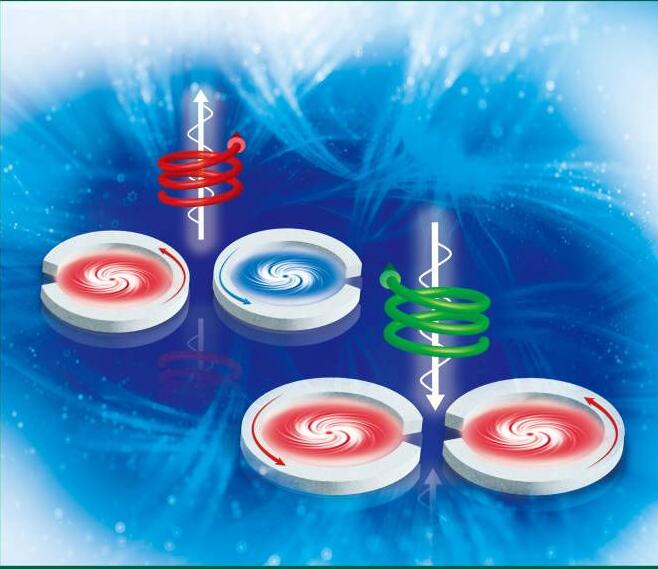SPECIAL TOPIC—Frontiers in non-Hermitian physics
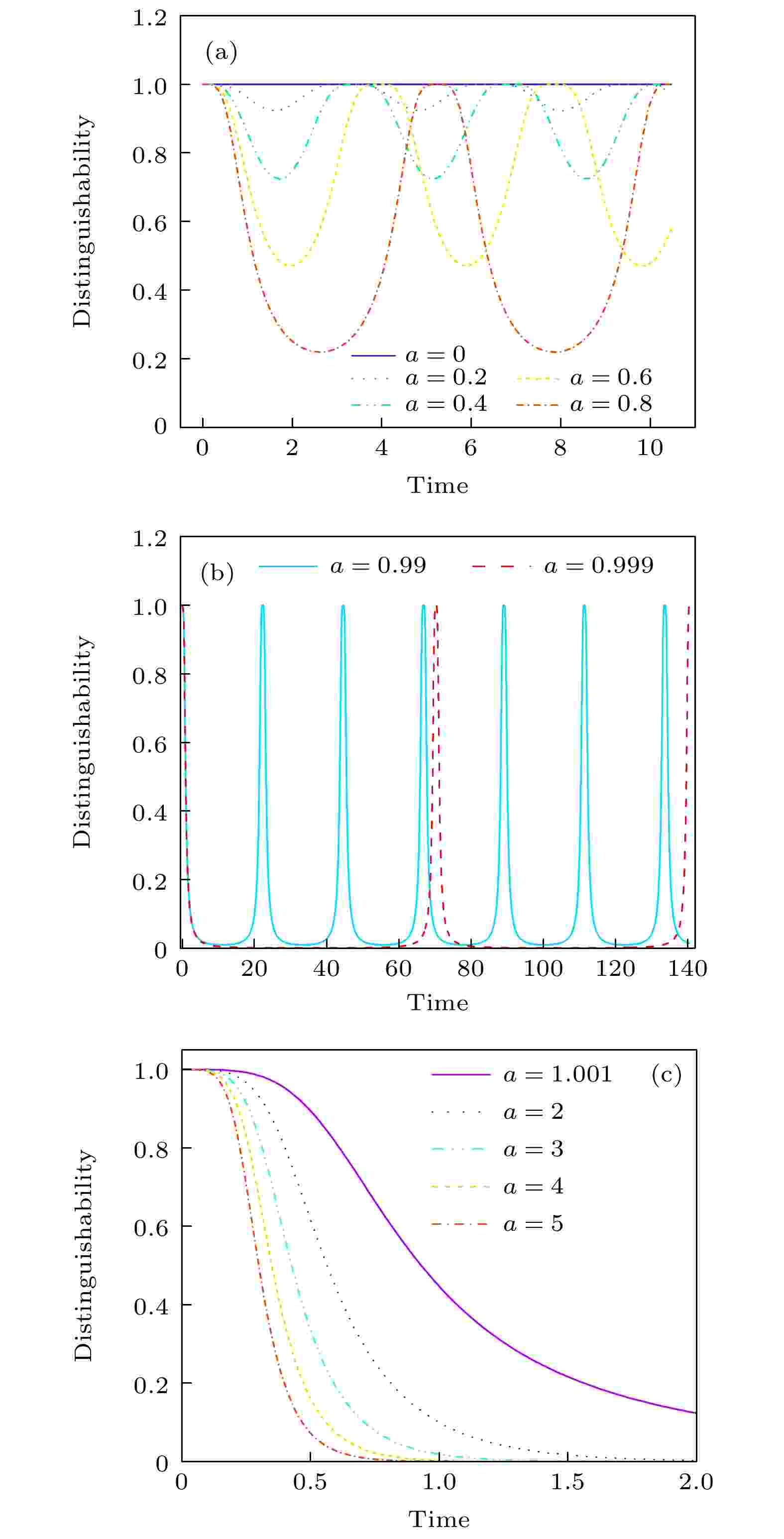
2022, 71 (13): 130301.
doi: 10.7498/aps.70.20220511
Abstract +
Recently, impressive progress has been made in the study of non-Hermitian systems with parity-time symmetry, such as observations of topological properties of physical systems and criticality at exceptional points. A crucial aspect of parity-time symmetric nonunitary dynamics is the information flow between the system and the environment. In this paper, we use the physical quantity, distinguishability between quantum states, to uniformly quantify the information flow between low-dimensional and high-dimensional parity-time symmetric non-Hermitian systems and environments. The numerical results show that the oscillation of quantum state distinguishability and complete information retrieval and can be obtained in the parity-time-unbroken phase. However, the information decays exponentially in the parity-time-broken phase. The exceptional point marks the criticality between reversibility and irreversibility of information flow, and the distinguishability between quantum states exhibits the behavior of power-law decay. Understanding these unique phenomena in nonunitary quantum dynamics provides an important perspective for the study of open quantum systems and contributes to their application in quantum information.

2022, 71 (13): 130302.
doi: 10.7498/aps.71.20220890
Abstract +
Non-Hermitian systems have attracted much attention during the past few years, both theoretically and experimentally. The existence of non-Hermiticity can induce multiple exotic phenomena that cannot be observed in Hermitian systems. In this work, we introduce a new non-Hermitian system called the non-Hermitian mosaic dimerized lattice. Unlike the regular nonreciprocal lattices where asymmetric hoppings are imposed on every hopping term, here in the mosaic dimerized lattices the staggered asymmetric hoppings are only added to the nearest-neighboring hopping terms with equally spaced sites. By investigating the energy spectra, the non-Hermitian skin effect (NHSE), and the topological phases in such lattice models, we find that the period of the mosaic asymmetric hopping can influence the system’s properties significantly. For a system with real system parameters, we find that as the strength of asymmetric hopping increases, the energy spectra of the system under open boundary conditions will undergo a real-imaginary or real-complex transition. As to the NHSE, we find that when the period is odd, there appears no NHSE in the system and the spectra under open boundary conditions (OBCs) and periodic boundary conditions (PBCs) are the same (except for the topological edge modes under OBCs). If the period of the mosaic asymmetric hopping is even, the NHSE will emerge and the spectra under different boundary conditions exhibit distinctive structures. The PBC spectra form loop structures, indicating the existence of point gaps that are absent in the spectra under OBCs. The point gap in the PBC spectrum is shown to be the topological origin of the NHSE under OBCs, which also explains the NHSE in our mosaic dimerized lattices. To distinguish whether the bulk states of the system under OBCs are shifted to the left or right end of the one-dimensional lattice due to the NHSE, we define a new variable called the directional inverse participation ratio (dIPR). The positive dIPR indicates that the state is localized at the right end while the negative dIPR corresponds to the states localized at the left end of the one-dimensional lattice. We further study the topological zero-energy edge modes and characterize them by calculating the Berry phases based on the generalized Bloch Hamiltonian method. In addition, we also find that the topological edge modes with nonzero but constant energy can exist in the system. Our work provides a new non-Hermitian lattice model and unveils the exotic effect of mosaic asymmetric hopping on the properties of non-Hermitian systems.

2022, 71 (13): 130303.
doi: 10.7498/aps.70.20220716
Abstract +

2022, 71 (13): 130701.
doi: 10.7498/aps.71.20220425
Abstract +
Quantum precision measurement is based on the basic principle of quantum mechanics by using the interaction between light, atoms and magnetism to measure physical quantities, also known as precision measurements based on microscopic particle systems and their quantum states. As an important means of quantum precision measurement, interferometer precision measurement technology has great application value in quantum communication. The linear interferometer measures the magnitude of the physical quantity by using the phase change obtained from the measurements, but measurement accuracy is limited and unable to meet the requirements of today's scientific problems for the precision measurement of some physical quantities. On this basis, nonlinear interferometer is able to take advantage of the quantum entangled state, that is, using the two light fields of quantum correlation characteristics to realize quantum enhanced precision measurement, thus greatly improving the measurement sensitivity, Therefore, the scope of application is wider, but the preparation of quantum entangled states has many limitations in practical manipulation. With the maturity of experimental conditions and technology, how to use both of these interferometers to further improve the measurement accuracy of the phase signal so as to break the limitation to shot noise, breaking the standard quantum limit and even approaching to the Heisenberg limit has become a frontier research topic . In this paper, we introduce several methods to improve the accuracy of parameter evaluation in the measurement process by using linear (including an atomic/photon interferometer) and nonlinear interferometer to call quantum resources at different stages. High-precision measurement can be achieved by inputting non-classical states into the interferometer, such as compressed state, bi-fock state, and NOON state. And we also introduce the weak measurement developed for the direct observation of quantum states and its application to non-Hermitian systems, and the multiparameter measurement proposed to eliminate the accuracy balance between parameters. Compared with the first two measurement methods, weak measurement method is based on the weak value amplification principle of an indirect measurement. Measurements are performed virtually without perturbing the quantum system, which does not lead the wave function to collapse, the weak value of the real and virtual part have different physical significance, The combination of weak measurement theory and non-Hermitian system also further improves the measurement sensitivity. Multi-parameter measurement uses quantum entanglement, quantum control and other quantum resources to make the measurement progress reach the Heisenberg limit, which is the current research hotspot in the field of precision measurement. Furthermore, we present a conjecture whether there will be multi-atomic mixing measurements based on atomic spin effects or ultra-high sensitivity measurement instruments with precision of fT or even aT by using other particles detection. Finally, several measurement methods are analyzed and compared with each other, and the development prospect of quantum precision measurement is forecasted.
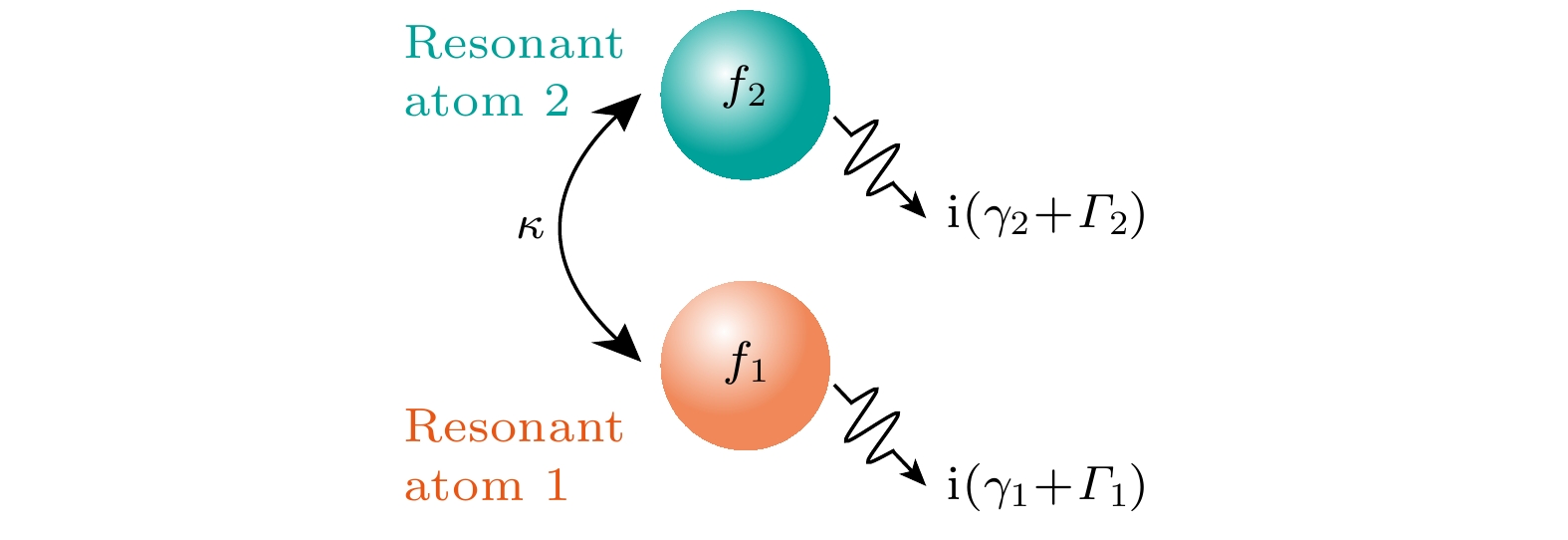
COVER ARTICLE
2022, 71 (13): 131101.
doi: 10.7498/aps.71.20220842
Abstract +
Based on the quantum mechanics, the physical observables are represented by Hermitian linear operators. Derived from the conservation of energy, these Hermitian operators exhibit real eigenvalues. However, when a closed system described by an effective Hamiltonian is coupled with the surrounding environment, the dynamics of the system itself becomes non-Hermitian dynamic. In general, the eigenvalues of an open optical non-Hermitian system are complex. Parity-time symmetric structure is the system composed of complex potentials, which is neither parity symmetric nor time reversal symmetric alone but is symmetric after operations of parity inversion and time reversal have been combined. The eigenvalue of the parity-time symmetric Hamiltonian can be found to be real, despite the non-Hermitian nature of the system. One of the most attractive properties of non-Hermitian system is the exceptional point, which is degenerate at which two or more eigenvalues and eigenstates of a non-Hermitian physical system coalesce. The unique topological features of EPs, forming a self-intersecting Riemann surface, have given rise to several exotic physical properties. As a kind of phase singularity in a physical system, exceptional point of non-Hermitian system gives rise to a plethora of counterintuitive phenomenon, such as the loss-induced transmission enhancement, unidirectional reflection and asymmetric state transfer. Especially, the eigenvectors of exceptional point are self-orthogonal and an inherent chirality can be determined because of the missing dimension. Chirality lies at the heart of the most fascinating and fundamental phenomena in modern physics, and how to impose a strong chirality and a switchable direction of light propagation in an optical system by steering it to an exceptional point is an interesting research topic. In this work, a non-Hermitian system is constructed based on the special metamaterial resonator of split-ring resonator, in which the sign of coupling coefficient can be flexibly controlled. Especially, the chiral inversion at an exceptional point of non-Hermitian system is observed experimentally. This sign of coupling coefficient controlled exceptional point not only paves a new way for studying the fundamental non-Hermitian physics in an open system, but also holds great potential in the applied photonic devices such as the efficient chiral mode converter and chiral antennas.
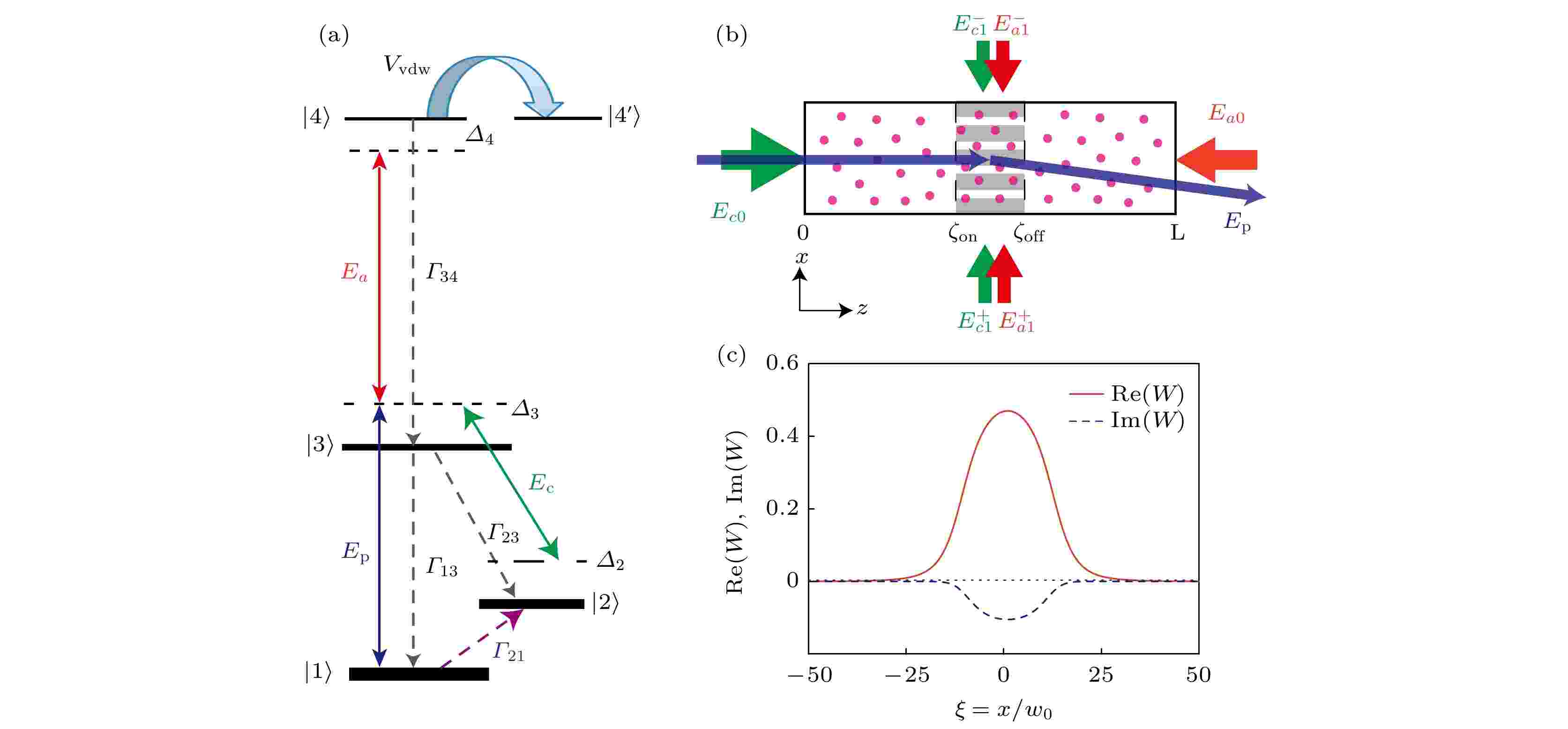
2022, 71 (13): 133202.
doi: 10.7498/aps.71.20220456
Abstract +
Based on a Rydberg-electromagnetically-induced-transparency (Rydberg-EIT) system, an electromagnetically induced grating (EIG) with parity-time (${\cal{PT}}$ ) symmetry is realized. The formation of solitons before the probe laser field reaching the EIG as well as its deflection when passing through the EIG are both investigated. It is found that due to the enhanced nonlinear optical effect of the Rydberg-EIT system, stable optical soliton can be formed with a very weak input light energy. In addition, it is found that by changing the gain/absorption coefficient of EIG, the period of EIG, and the nonlocality degree of optical Kerr nonlinear of the system, the deflection degree of the optical soliton can be effectively changed and manipulated. The research results of this work can provide a theoretical basis for the future applications of ${\cal{PT}}$ -symmetric EIG and may be useful in the fields of all-optical manipulation and optical information processing.
REVIEW

EDITOR'S SUGGESTION
2022, 71 (13): 131201.
doi: 10.7498/aps.71.20220148
Abstract +
In this review article, we show an important aspect of electron-positron pair production from vacuum under strong background field where the frequency chirping plays a key role in enhancing the pair production. A series of researches on the enhancement effect of frequency chirp on electron-positron pair production in strong field is summarized. Three approaches are introduced, i.e. the Dirac-Heisenberg-Wigner formalism used to treat the spatial inhomogeneous field or/and multidimensional homogeneous time-dependent field, quantum Vlasov equation to cope with the one-dimensional homogeneous time-dependent field, and the computation quantum field theory employed to study the problem with external potential. Some interesting results about the momentum spectrum structure of created particle and the yielding of pair numbers are demonstrated for various different field parameters such as field strength and central frequency, in particular their significant influence on results when the frequency chirping form or/and strength are changed. In general, the number density can be improved by 2-3 orders of magnitude with the strengthening of frequency chirping in comparison with that without chirping for low frequency field, which is attributed to the effect that the dynamically assisted mechanism plays a significant role since the chirping expands the frequency spectrum of field. For high frequency field, however, this effect is suppressed so that the number density is enhanced by about a few times. For spatially inhomogeneous field, field changing on a small scale does not make the number density so high and the frequency chirping can enhance the yield in the order of magnitude, while the field changing on a large scale makes the number density to approach to that of homogeneous field and the chirping increases the yield by a few times. These numerical results can be understood by the Wentzel-Kramer-Brillouin (WKB) approximation and the structure of turning points. Finally the possible applicable prospects of the electron-positron pair production by the frequency chirping are presented briefly.
SPECIAL TOPIC—Recent advances in hardware, algorithms and software of quantum computers

EDITOR'S SUGGESTION
2022, 71 (13): 133701.
doi: 10.7498/aps.71.20220224
Abstract +
Ion trap system is one of the main quantum systems to realize quantum computation and simulation. Various ion trap research groups worldwide jointly drive the continuous enrichment of ion trap structures, and develop a series of high-performance three-dimensional ion trap, two-dimensional ion trap chip, and ion traps with integrated components. The structure of ion trap is gradually developing towards miniaturization, high-optical-access and integration, and is demonstrating its outstanding ability in quantum control. Ion traps are able to trap increasingly more ions and precisely manipulate the quantum state of the system. In this review, we will summarize the evolution history of the ion trap structures in the past few decades, as well as the latest advances of trapped-ion-based quantum computation and simulation. Here we present a selection of representative examples of trap structures. We will summarize the progresses in the processing technology, robustness and versatility of ion traps, and make prospects for the realization of scalable quantum computation and simulation based on ion trap system.
GENERAL
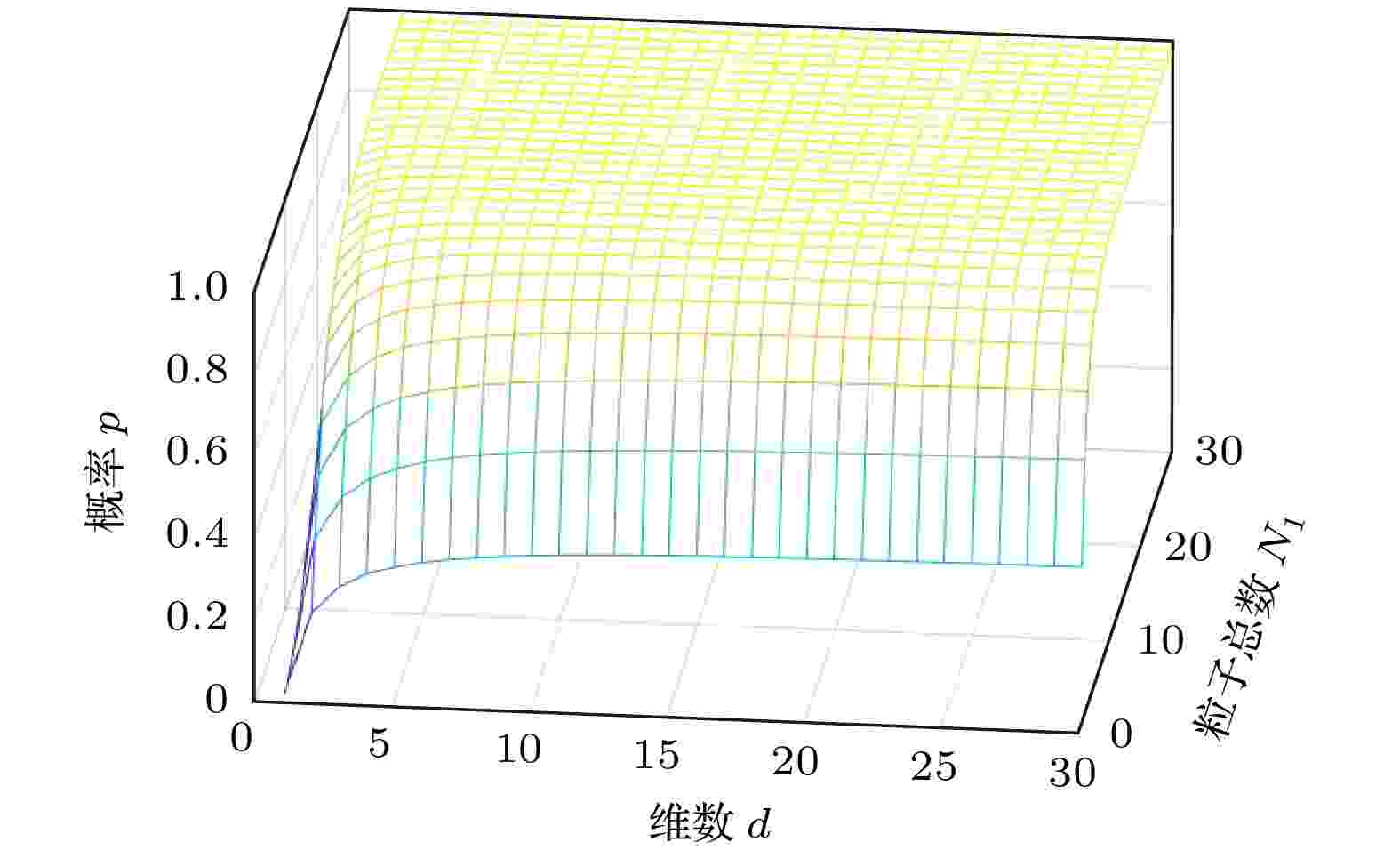
2022, 71 (13): 130304.
doi: 10.7498/aps.71.20211702
Abstract +
Semi-quantum secure direct communication allows the quantum party and the classical party to transmit secure messages directly, but does not need sharing a secret key in advance. To increase the information transmission efficiency and practicability of semi-quantum secure direct communication, a bidirectional semi-quantum secure direct communication protocol with high-dimensional single-particle states is designed. The proposed protocol involves quantum party Alice and classical party Bob. Each participant can receive a secret message while sending a secret message. Unlike most of existing quantum secure direct communication protocols, it is not necessary for the classical party Bob in the proposed protocol to possess the capability of measuring quantum states, which greatly enhances the feasibility of the protocol. The protocol allows the classical party Bob to implement the unitary operations on particles and reorder the quantum sequence. Furthermore, the quantum party Alice and the classical party Bob can verify the correctness of the received secret message with the Hash function. Security analysis indicates that without being discovered by the legitimate participants, Eve cannot obtain the secret message with common attack, such as intercept-resend attack, measure-resend attack, tampering attack and entanglement-measure attack. Compared with the typical semi-quantum secure direct communication protocols, the proposed protocol has a high qubit efficiency of about 28.6%. In addition, the transmission efficiency of secret message is greatly enhanced, since the proposed protocol utilizes the high-dimensional single-particle states as the carrier of secret message.

EDITOR'S SUGGESTION
2022, 71 (13): 130305.
doi: 10.7498/aps.71.20220477
Abstract +
On-demand quantum memory is an important step towards practical applications in various quantum information tasks such as long-distance entanglement distribution, quantum computation, and quantum networks. In this work, based on stimulated Raman adiabatic passage (STIRAP) protocol, we introduce a controllable delay between the reading pulse and writing pulse so that the quantum state can be stored in the superconducting waveguide and finally retrieved on demand with high fidelity. Through systematic numerical simulations, we find that if the duration of the writing pulse is set to be in a certain range, the readout unit is capable of retrieving the quantum state stored in the waveguide with high fidelity at any moment after a critical time. Moreover, we also investigate the robustness of our protocol, and find that the fidelity is robust against both the average number of thermal photons in the waveguide and the duration of the reading pulse. The numerical results also show that the pulse area in our protocol is only about one third of that in the original STIRAP protocol. Our protocol provides a practical way to combine the advantages of both on-demand quantum memory and the STIRAP protocol.

2022, 71 (13): 130306.
doi: 10.7498/aps.71.20220120
Abstract +
The physical effects such as random birefringence of fiber optic channels due to environmental influences make the optical signals transmitted in them have sensitive polarization variations, which seriously affects the performance of polarization biased code quantum key distribution systems. In this paper, a low-noise fiber channel wavelength division multiplexing real-time polarization compensation system is presented, where single photon counting is used as a feedback signal. The system can acquire the fiber channel polarization change information by detecting the photon counting of the conjugate reference light. In the system, the compensation algorithm is designed to control the electric polarization controller to calibrate the polarization state of the quantum signal light under the corresponding polarization base in real time, and the stable fiber channel polarization compensation is successfully achieved. In order to verify the effectiveness of the compensation system, a quantum key distribution test based on BB84 protocol with a transmission distance of 25.2 km is conducted, and stable test results of up to 8 hours are obtained in the laboratory environment and the simulated metropolitan area network buried fiber environment, with the average quantum bit error rate being 0.52% and 1.25%, respectively. The experimental results show that this system can guarantee the stable operation of polarization-encoded quantum key distribution in the buried fiber environment in urban areas.

2022, 71 (13): 130307.
doi: 10.7498/aps.71.20212341
Abstract +
Continuous variable quantum teleportation (CVQT) plays an important role in practical quantum communication. However, the noise and loss in the actual environment will lead to the degradation of entanglement, which has an effect on the performance of the system in terms of the transmission distance and hence hinders its implementations. In this paper, we suggest an approach to improving the performance of the CVQT system with an embedded noiseless linear amplifier (NLA). By using the NLA, one can amplify the degenerated entangled source to compensate for the attenuation of the fiber. Then we consider the influences of the available gains of the NLA on the performance of the proposed scheme under different lossy channels and entangled sources. The simulation results show that the performance is improved in fidelity and transmission distance, which may provide a feasible and effective method of putting the long-distance CVQT into practical application .
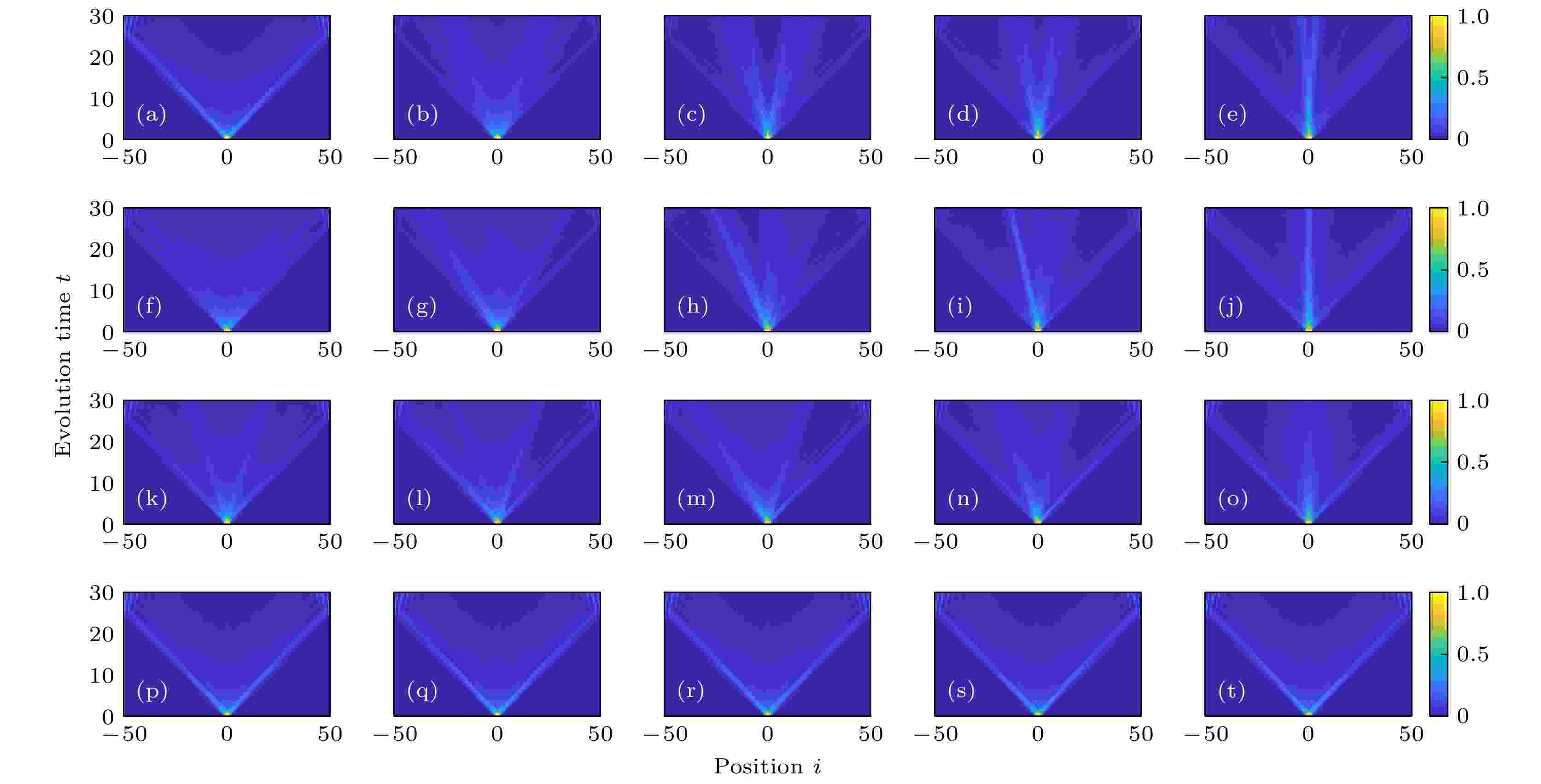
2022, 71 (13): 130501.
doi: 10.7498/aps.70.20220188
Abstract +
Anyons, namely particles obeying fractional quantum statistics that interpolate between bosons and fermions, possess a lot of new and exotic physical properties related to the particle exchange statistics. In this work, we explore the few-body quantum dynamics and quantum correlations of indistinguishable anyons with on-site interactions in one-dimensional lattices within the scheme of three-body continuous-time quantum walks. By employing a time-evolving block decimation (TEBD) algorithm, we numerically calculate the dynamical evolution process of the local density distribution of anyons among the whole lattice. Numerical simulations shown in the main text mainly focus on a three-body initial state as $ \left|\psi(t=0)\right>=\hat{a}_{-1}^{\dagger}\hat{a}_{0}^{\dagger}\hat{a}_{1}^{\dagger}\left|0\right>$ , in which three particles are located on neighbouring sites at lattice centre. This choice of initial state features that the three particles influence one another most strongly, while we have also implemented numerical simulations on other choices of three-body initial states as are discussed in appendix. It is shown that the local density distribution of anyons is dramatically altered by fractional particle statistics with new dynamical structure showing up during the time evolution. For free anyons, an inner cone emerges as the statistical parameter increases, while the outer cone remains robust all along. When the on-site interaction joins in, the structure of the inner cone is further modified with new features. Specifically, for interaction of finite strength, an exotic dynamical asymmetry in real space, is clearly demonstrated during the time evolution of the local density distribution for particles within the fractional statistics regime. However, for boson limit and pseudofermion limit, the time evolution of the local density distribution keeps symmetric as the three-body initial state. And remarkably, the dynamical asymmetry is interaction-dependent manifested as the local density distribution of anyons favors opposite side of the lattice for repulsive and attractive interaction, respectively. Moreover, when the on-site interaction is further increased to hard-core limit, the dynamical asymmetry will then be largely suppressed. We also calculate the density-density correlations for anyons before they reach the lattice boundary to reveal the interesting effect of fractional statistics on quantum correlations. It is shown that the inner cone corresponds to co-walking of anyons, while the outer cone is related to individual walking and is immune to the variation of statistical parameter. Furthermore, the exotic real-space asymmetry originated from the interplay of fractional statistics and finite interaction is also shown up in the density-density correlations.
ATOMIC AND MOLECULAR PHYSICS
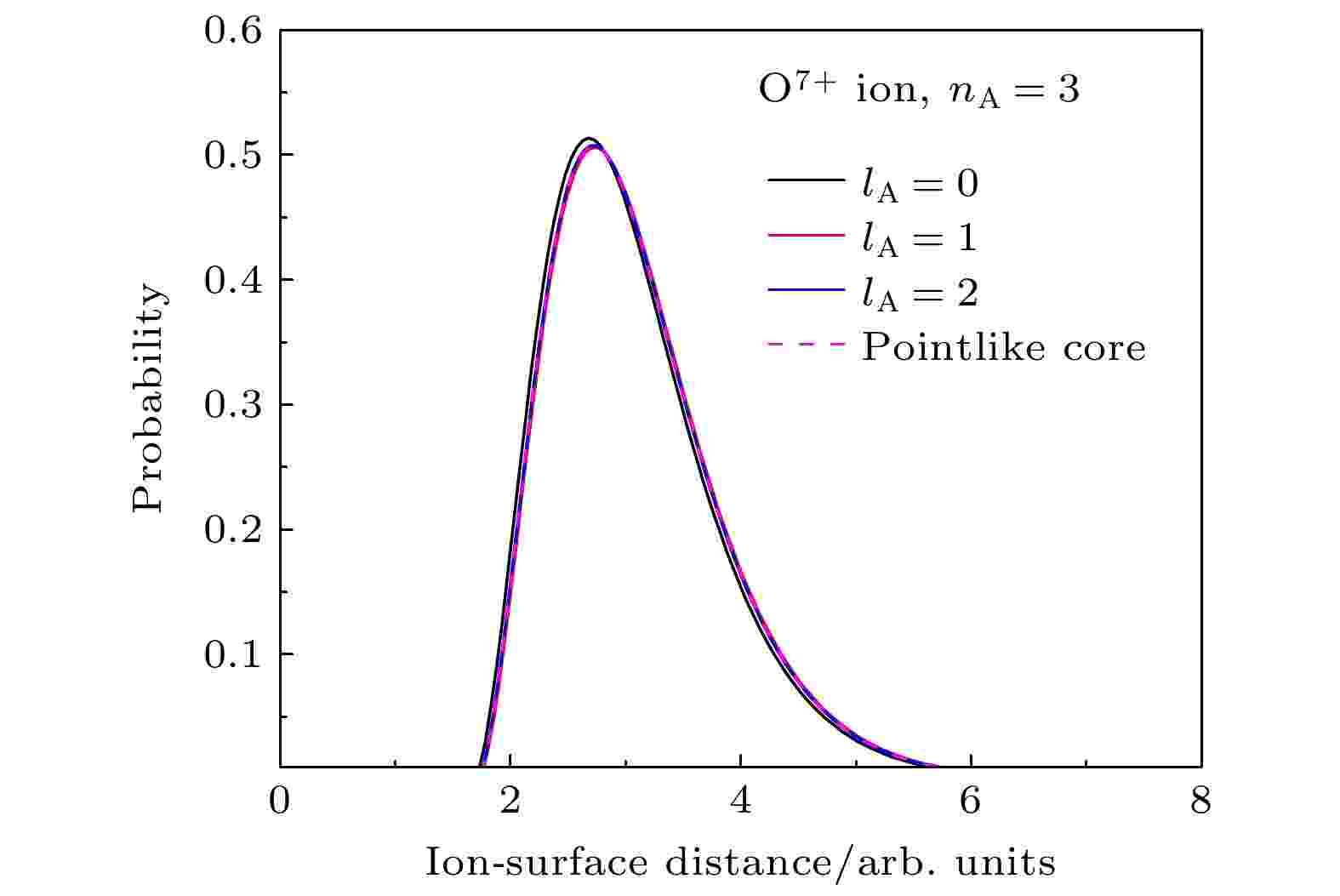
EDITOR'S SUGGESTION
2022, 71 (13): 133201.
doi: 10.7498/aps.70.20212434
Abstract +
The study of the interaction between highly charged ions and solid surfaces not only has great significance for basic scientific research such as atomic physics, astrophysics, and high energy density physics but also has promising application prospects in biomedicine, nanotechnology, surface analysis, and microelectronics. In this paper, the intermediate Rydberg states formed during highly charged ${\rm{O}}^{7+}$ and ${\rm{N}}^{6+}$ ions incident on Al surface are studied theoretically by using the two-state vector model. Both the probability of electron capture into different Rydberg states $\left(n_{A}=2-7\right)$ and the most probable neutralization distances are given. The calculation shows that the larger principal quantum number $n_{A}$ is relevant to smaller probability. Therefore, the X-rays emitted by ${\rm{O}}^{7+}$ and ${\rm{N}}^{6+}$ ions incident on the Al surface come mainly from the de-excitation of the smaller $n_{A}$ to the ground state. In order to confirm the calculations, we measured the X-ray emission spectra of ${\rm{O}}^{7+}$ and ${\rm{N}}^{6+}$ ions in collisions with the Al surface in the energy range of 3–20 keV/q. The experiments were performed at an ECR ion source located in Institute of modern physics. We also calculated the transition energies (np–1s) from different high Rydberg states to the ground state by using the FAC code. The center of the measured K X-ray peak is close to the calculated transition energy from the principal quantum number n = 2 to n = 1, it is consistent with our results obtained by the two-state vector model as well. In addition, we found the experimental K X-ray yield for ${\rm{O}}^{7+}$ ions incidence at lower energy collisions is almost the same with ${\rm{N}}^{6+}$ ions, but larger at higher energy collisions. When the ion incident kinetic energy is low, the X-ray emission is mainly owing to the decay of “above the surface” hollow atoms. Because of the small difference in the critical distances for the capture of electrons by ${\rm{O}}^{7+}$ and ${\rm{N}}^{6+}$ to form hollow atoms, the X-ray yields produced in both cases are almost the same at low energy collisions. In contrast, as increasing the incident energy, the ions have a long-range in the target, so the contribution from the decay of “above the surface” and “below the surface” hollow atoms need to be considered at the same time.
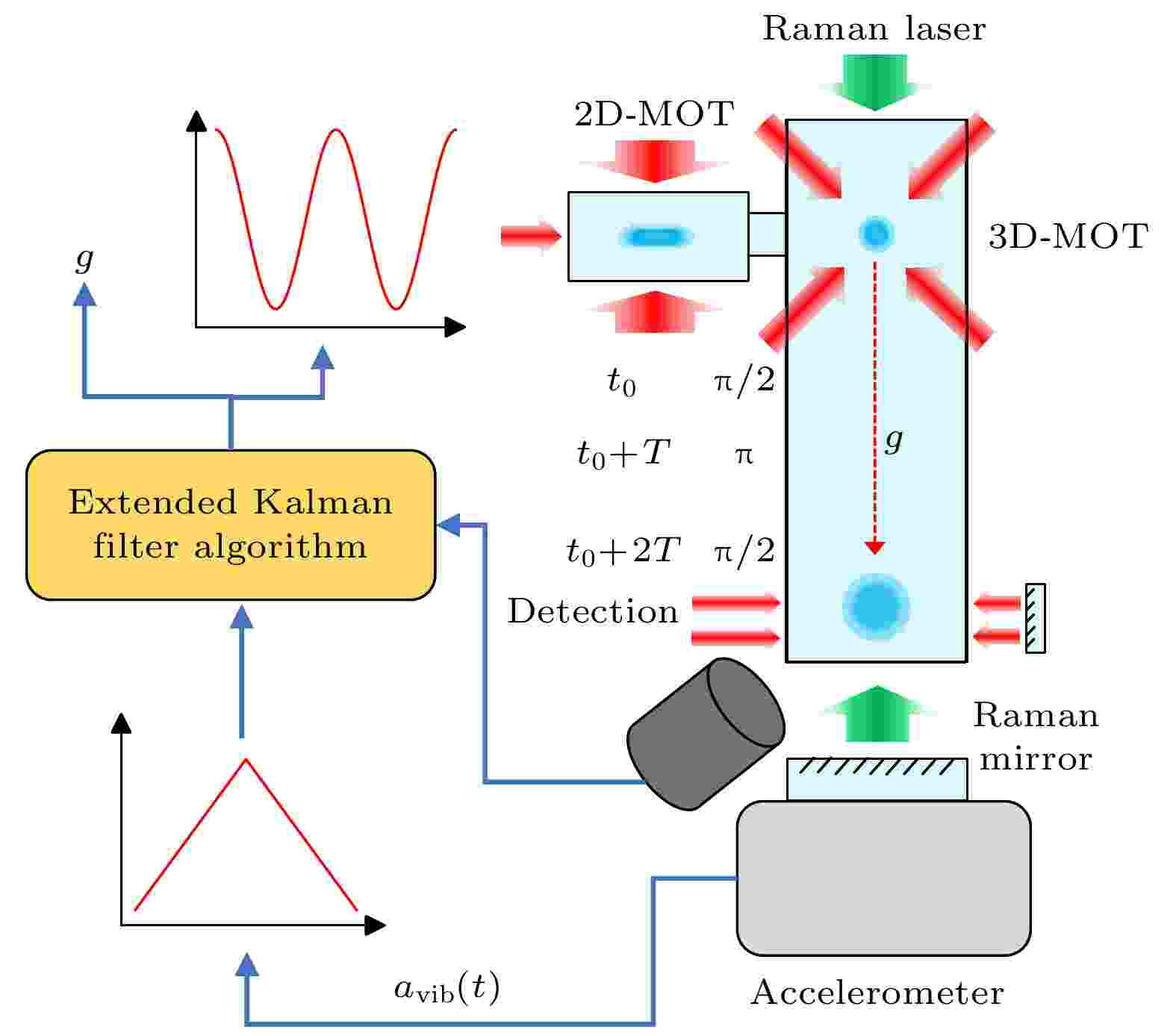
2022, 71 (13): 133702.
doi: 10.7498/aps.71.20220071
Abstract +
The precision dynamic measurement of absolute gravity based on the cold atom interferometer can provide a new method for marine gravimetry, so that it has attracted more attention. Based on the homemade shipborne cold atom interferometric absolute gravity measurement system, we carry out a series of measurement experiments in a certain area of the South China Sea. Under dynamic conditions, the suppression of measurement noise is essential for the improvement of the measurement performance. According to the physical model of the measurement system, in this paper a data processing method is proposed based on the extended Kalman filter algorithm for the absolute gravity dynamic measurement. The observed atomic interference fringe data are filtered in the time domain to estimate the absolute gravity value. Based on this processing method, the sensitivity of absolute gravity measurement under the condition of ship speed less than 2.1 km/h is improved from 300.2 mGal/Hz1/2 to 136.8 mGal/Hz1/2 (T = 4 ms). Comparing the processed data with the data calculated from the earth gravity model (XGM2019), it is found that both of the data are in good agreement. These results confirm the effectiveness of the data processing method proposed in this paper, and provide a new processing method of suppressing the measurement noise of shipborne cold atom interferometric absolute gravity measurement system.
ELECTROMAGNETISM, OPTICS, ACOUSTICS, HEAT TRANSFER, CLASSICAL MECHANICS, AND FLUID DYNAMICS

2022, 71 (13): 134201.
doi: 10.7498/aps.71.20220178
Abstract +

2022, 71 (13): 134202.
doi: 10.7498/aps.71.20212010
Abstract +
Traditional metallic meshes are a two-dimensional square structure with high optical transmittance loss, and the diffraction of light seriously interferes with the imaging quality of the detection system. In this work a metallic network conductive film with a random hexagonal surface structure is designed. This structure has a higher optical transmittance than conventional square metallic meshes. As a result of the random variables in the structure, it can also suppress the stray light of high-order diffraction. Then we prepare a metallic network conductive film on a ZnS optical window with a line width of 4 μm and a period of 100 μm. The metal lines of the sample are clear, the line width is uniform, and there is no dotted line. The transmission loss of the ZnS optical window is 10.5% in the long-wave infrared band (LWIR) band but only 6.8% in the visible band, which has low energy loss. At the same time, it can achieve uniform optical diffraction, thus reducing the imaging interference to the photoelectric detection system. The numerical simulation results show that the average EMI shielding efficiency is 37.9db, which is in an electromagnetic spectrum range from 0.2 GHz to 20 GHz, and its minimum shielding efficiency is 29.6 dB, which is 3.2 dB higher than the traditional square mesh’s. The random hexagonal structure metallic network conductive films designed and prepared in this paper have excellent optical properties and EMI shielding efficiencies, which is of great significance in improving the comprehensive performance of the graphical optical window.

EDITOR'S SUGGESTION
2022, 71 (13): 134203.
doi: 10.7498/aps.70.20220238
Abstract +
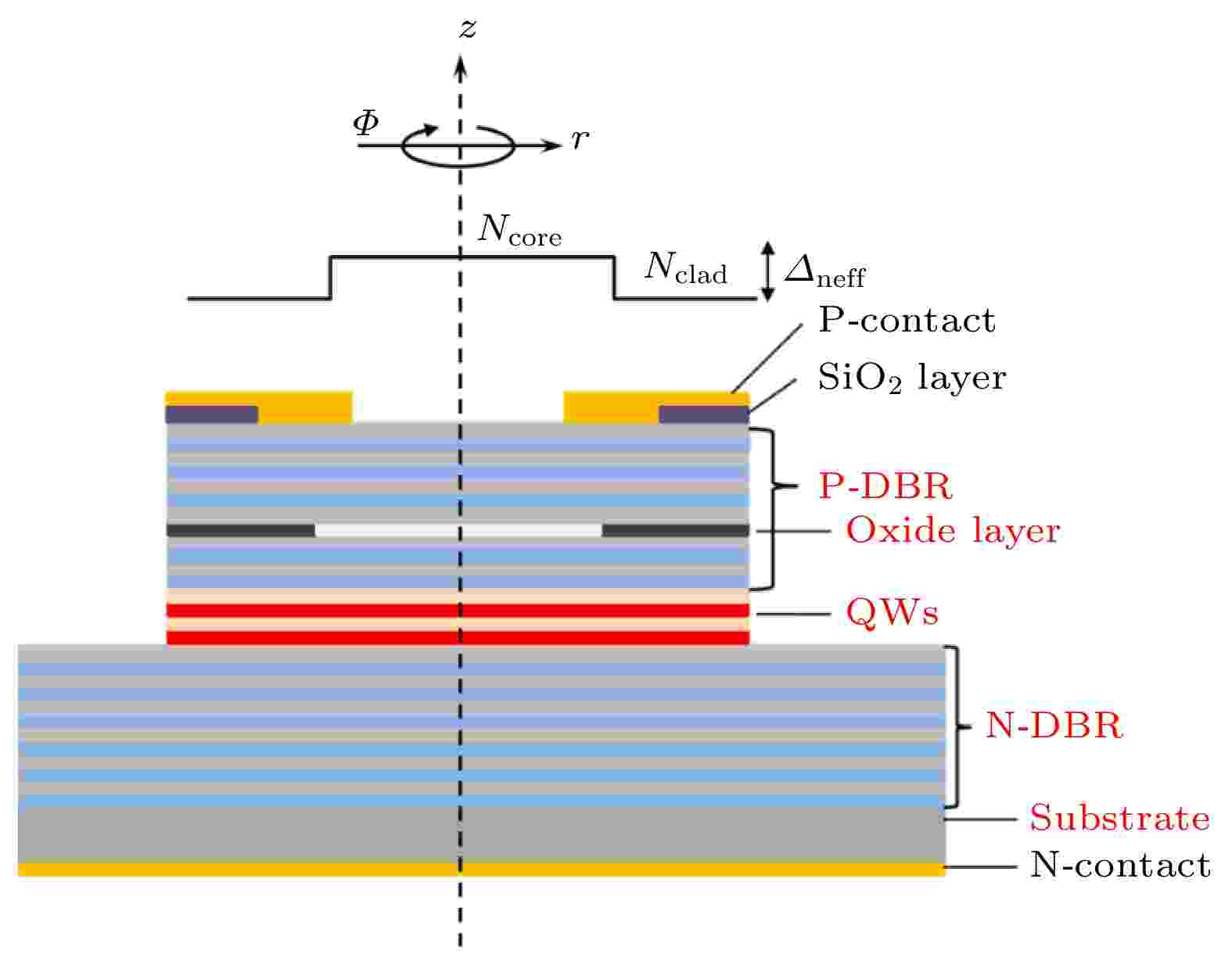
EDITOR'S SUGGESTION
2022, 71 (13): 134204.
doi: 10.7498/aps.71.20212422
Abstract +
Single-transverse mode vertical-cavity surface-emitting lasers (VCSELs) are preferable optical sources for small low-power atomic sensors, including chip-scale atomic clocks, magnetometers, and gyroscopes.When VCSEL is used as the pump source of nuclear magnetic resonance gyroscope, it is required to have high single-mode output power. Oxide aperture diameter must be sufficiently small (< 4 µm) in a conventional oxide-confined VCSEL to support the fundamental mode alone. However, high series resistance (typically > 200 Ω for GaAs-based VCSEL) from the small aperture limits its output power and reliability due to excessive current-induced self-heating and high current density. It is a very attractive idea to achieve high power operation of an intrinsic single mode VCSEL based on a large oxide aperture by means of epitaxial structure design without introducing additional process steps. Transverse optical confinement in oxide-confined VCSELs crucially depends on the thickness of oxide layer and its position relative to standing wave. Modifying the structure reduces the overlap between the oxide layer and the standing wave as well as the difference in effective refractive index between core and cladding of the VCSEL, thereby reducing the number of transverse modes andincreasing the mode extension beyond oxide aperture. A 795-nm VCSEL is designed and fabricated based on this concept. A cavity structure of VCSEL with gain-cavity detuning of ~10.8 nm at room temperature is adopted in this paper. The effective refractive index and the standing wave distribution of the VCSEL are calculated, and the position of the oxide layer in the epitaxial structure of the VCSEL is optimized according to the standing wave distribution. Finally, the structure with low effective refractive index difference is obtained. The proposed device achieves high single-mode operation of 4.1 mW at 80 ℃, SMSR of 41.68 dB, and OPSR of 27.4 dB. The VCSEL is applied to a nuclear magnetic resonance gyroscope (NMRG) system as pump source due to its excellent device performance, and satisfactory test results are obtained. This paper presents a new method of designing single-mode high power VCSEL and its feasibility is also demonstrated through experimental results.
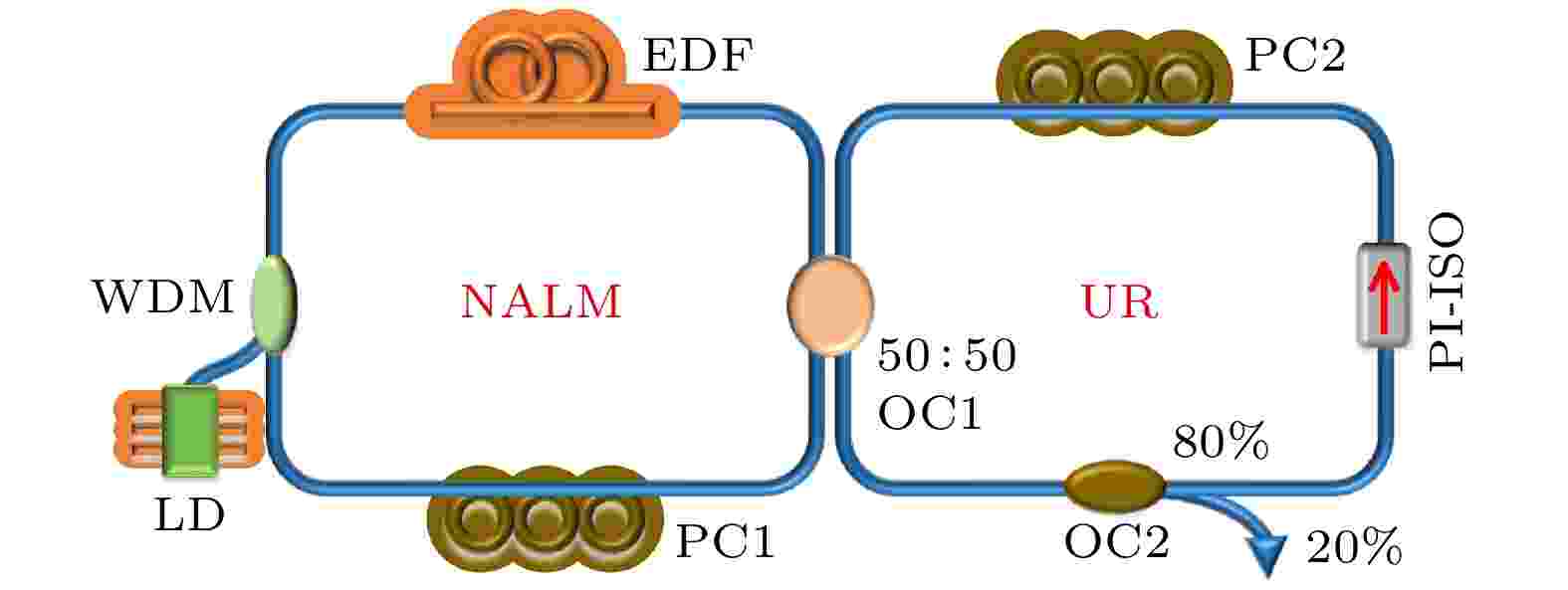
2022, 71 (13): 134205.
doi: 10.7498/aps.71.20220250
Abstract +
Dissipative solitons (DSs) usually play an important role in understanding the intricate phenomena in various nonlinear systems. As a special regime in the dissipative system, noise-like pulses (NLPs) can have typical characteristics of ultra-broad and smooth spectrum, high pulse energy and low temporal coherence, making them a good candidate for many applications, including supercontinuum generation, industrial micromachining and optical metrology. In this paper, a noteworthy observation concerning the dynamics on coexistence of the multiple solitons and NLPs operation in a net-normal-dispersion passively mode-locked fiber laser based on nonlinear amplifying loop mirror (NALM) is reported. In the experiment, the stable DSs can be easily obtained at a proper pump power. When appropriately increasing the pump power and changing the polarization state, the DS operation can change to the NLP regime. When the fiber laser operates in an NLP state, the single soliton bunch contains multiple pulses with different temporal spacings. And the temporal interval between the adjacent pulses is in a range of several hundred picoseconds, which decreases from left to right with time changing, indicating that there are long-distance interactions among these multiple pulses and they gradually become stronger and stronger. Besides, the pulse number of single soliton bunches on the NLP operation increases almost linearly with pump power increasing. At a maximum pump power, there are eight pulses inside the single soliton bunch. With the increase of pump power, the average output power and pulse energy of these multiple solitons in the NLP state increase. The maximum average output power and pulse energy are 12.3 mW and 1.65 nJ, respectively. In addition, the real-time dynamic evolution of these multiple solitons in the NLP state is investigated by using the time-stretch dispersive Fourier-transform method. The results show that all the pulses in NLP regime actually consist of chaotic noise waves with stochastic intensities. We believe that this paper will be of significance in studying ultrafast fiber lasers and nonlinear optics. Moreover, we hope that these findings will be helpful in understanding the physical mechanism of NLPs and paving the way for exploring other complex soliton dynamics.

2022, 71 (13): 134206.
doi: 10.7498/aps.71.20220016
Abstract +
Mid-infrared band 3–5 ${\text{μm}}$ laser light source has important applications in many fields such as medical treatment, basic science, communication, and industry. Owing to the limitation to available efficient gain media in the mid-infrared band, the traditional methods of generating and amplifying lasers , such as regenerative amplification, are no longer applicable. In order to produce broadband and high-energy mid-infrared laser, in this work we combine quasi-phase matching technology and chirped periodically polarized lithium niobate (CPPLN) crystal for theoretical analysis and numerical design. The second-order nonlinear difference-frequency generation (DFG) process is used to implement the generation of mid-infrared laser via CPPLN. In the differential frequency process, the pump light used is 800 nm in wavelength and the wavelength range of signal light is 0.95–1.6 ${\text{μm}}$ . By calculating the dispersion curve of CPPLN crystal, the phase mismatch of difference frequency generation processes with different light signals is obtained. Under the condition of quasi-phase matching, the CPPLN with deliberately poling structures is designed and used to provide phase mismatch compensation in a broad bandwidth. The designed structure can meet the generation of mid infrared laser in a 1.6–5$ {\text{μm}} $ band according to the numerical simulations. The conversion efficiencies of mid-infrared laser with different wavelengths at different positions in the crystal are obtained by using nonlinear coupled wave equations and fourth-order Runge-Kutta method. The results show that the mid-infrared laser in a wavelength range of 1.6–5 $ {\text{μm}} $ can be produced efficiently in a single CPPLN crystal, with an average conversion efficiency of about 15%. The theoretical analysis and numerical simulation for the designed CPPLN crystal can provide good schematic reference and theoretical support for further experimental exploration on generation of mid-infrared laser.

2022, 71 (13): 134207.
doi: 10.7498/aps.70.20212194
Abstract +
Owing to the unique characteristics of the hollow core fiber(HCF), more and more researchers pay attention to its application. Because the mode field is mainly limited to the core region of the fiber, which results in low non-linearity, ultra-low group velocity dispersion, low temperature sensitivity, and high material damage threshold. Based on the above, the HCF possesses some attractive nonlinear applications such as in transmission of high-power laser beams, sensing, ultra-wide band low-loss transmission, pulse compression and super-continuum generation. Besides, the HCFs can be further divided into the transmitting band-gap photonic crystal fiber(PBG-PCF) and the hollow-core anti-resonant fiber(HC-ARF). Compared with the PBG-PCF, the latter has wide light guiding characteristics caused by leaking modes. According to the research in the recent year, the HC-ARF has gradually approached to the performance of the PBG-PCF in its transmission loss, showing that it has potential applications in communications, sensing, aerospace, high-power laser transmission and other fields in the future. In addition, the HC-ARF with the special light-guiding properties has also become the important photonic device in the fields of fiber filters, mode conversion, etc. In this paper, a hollow-core anti-resonance fiber is studied and its light transmission performance in the spectral range of 500–1500 nm is verified. The optical loss measured at 980 nm wavelength is about 0.32 dB/m. It is found that a 980 nm multi-mode laser beam can be converted into a single-mode one after transmitting through the hollow core fiber we designed.

2022, 71 (13): 134301.
doi: 10.7498/aps.71.20212355
Abstract +
The physical ocean phenomena in the ocean affect the changes of water body, which has an important influence on the sound propagation. A hyperbolic frequency modulation (HFM) signal sound propagation experiment of towed sound source in the East Indian Ocean (EIO) was conducted in summer 2019. The center frequency of the towed sound source is 300 Hz, and the hydrophone receives the data from 4130 m far. This is the first time that we have conducted the underwater acoustic survey in the Indian Ocean. The influence of the physical ocean phenomenon—Indian Ocean Dipole (IOD) on sound propagation is observed. The experimental data of sound propagation from the IOD are processed and analyzed, the effects of sound source depth and water fluctuation on the deep-sea convergence zone (CZ) are analyzed, and the formation mechanism of sound propagation phenomenon in the experiment is explained theoretically. The results show that the second CZ is not formed under the influence of the warm water mass formed by the IOD and the depth of the sound source in the incomplete deep channel environment of the EIO. Owing to the fluctuation of the sound source depth, the deep-sea CZ disappears at the distance where it should have appeared. When the depth of the sound source becomes deeper, it is easier to form the deep-sea CZ. Under the influence of the IOD, the thermocline fluctuation at the location of the second CZ has an important influence on the formation and location of the third CZ. It is found that the location of the third CZ shifts 2–3 km toward the sound source in the experiment. The research results have important significance in guiding the applications in detection and communication sonar in deep-sea complex environment.

2022, 71 (13): 134302.
doi: 10.7498/aps.71.20211987
Abstract +
In this paper, the peak migration line of cross-correlation output is utilized to discriminate the depth of an underwater acoustic source in shallow water environment with a negative thermocline through studying the modal arrival structure of the source at different depths. The discrimination can be done according to the position of the migration line when the cross-correlation delay is zero since the type of dominant normal mode is determined by the depth of the source. Firstly, using the beam output of a vertical linear array and the received signal of a single array element to do cross-correlation processing, a two-dimensional intensity image of cross-correlation delay versus elevation angle is obtained. Then, the peaks in the angle domain at different delays can be extracted from the image. The cross-correlation peak migration line can be achieved by piecewise linear fitting which is divided into two parts corresponding to the delay being less than or equal to zero and the delay being more than zero, respectively. Finally, the source depth is determined by the position of the curve where the cross-correlation time delay is zero. Theoretical analysis shows that the migration line is little influenced by the sound velocity profile (SVP) varying with depth, the discrimination threshold is determined by the lower-order normal modes, the identification region is determined by the thickness and depth of the thermocline and the higher strength of the thermocline is instrumental in distinguishing. The numerical results and the experimental results prove the method's effectiveness which can be implemented without SVP details or mode separation, or source movement.

2022, 71 (13): 134701.
doi: 10.7498/aps.71.20212327
Abstract +
In this paper we study the rotating electroosmotic flow of a power-law fluid with Navier slip boundary conditions under high zeta potential subjected to the action of a vertical magnetic field in a variable cross-section microchannel. Without using the Debye–Hückel linear approximation, the finite difference method is used to numerically calculate the potential distribution and velocity distribution of the rotating electroosmotic flow subjected to an external magnetic field. When the behavior index $n = 1$ , the fluid obtained is a Newtonian fluid. The analysis results in this paper are compared with the analytical approximate solutions obtained in the Debye–Hückel linear approximation to prove the feasibility of the numerical method in this paper. In addition, the influence of behavior index n, Hartmann number Ha, rotation angular velocity $\Omega $ , electric width K and slip parameters $\beta $ on the velocity distribution are discussed in detail. It is obtained that when the Hartmann number Ha > 1, the velocity decreases with the increase of the Hartmann number Ha; but when the Hartmann number Ha < 1, the magnitude of the x-direction velocity u increases with the augment of Ha.

2022, 71 (13): 134702.
doi: 10.7498/aps.71.20212203
Abstract +
Aluminum-based composite material is one of the most important candidate materials in the mechanical industry and aerospace engineering due to its light weight and high strength. Graphene is an ideal reinforcement for composite materials for its excellent mechanical properties. Till-now, the contribution of graphene sheets in the process of crack propagation in composites is not clear. In present work, the effects of graphene size and distribution in graphene/aluminum composites are explored using molecular dynamics simulation methods. It is found that when the length of graphene flake is less than 3.35 nm, the generated sub-cracks in the composite is benefit to the crack propagation. This effect reduces the mechanical properties of composite. When the length of graphene flake is greater than 3.35 nm, graphene sheet impedes the crack propagation and dislocates slip at sub-cracks. In addition, the distribution of graphene flakes angle changes the crack propagation path. Our findings also provide insights into ways to optimize mechanical properties of graphene/aluminum composites.

2022, 71 (13): 134703.
doi: 10.7498/aps.70.20220346
Abstract +
Hydrodynamic cloaks have attracted extensive attention because of their ability to significantly reduce the surface resistance of designated target. However, most of parameters of traditional hydrodynamic cloaks present inhomogeneous and anisotropy, which increases the challenge of manufacturing hydrodynamic cloaks for us. To overcome this limitation, equivalent medium theory and integral median theorem are used to homogenize the parameters of hydrodynamic cloaks. Numerical simulations verify that the simplified homogeneous hydrodynamic cloaks exhibit the equivalent cloaking effect as inhomogeneous hydrodynamic cloaks, which can be applied to different flow fields as well. This simplified method not only can simplify inhomogeneous hydrodynamic cloaks to homogeneous hydrodynamic cloaks, but also can be applied to other physical fields, such as optics, acoustics, electromagnetics, and thermodynamics among other areas for the homogenization of metamaterial design, providing a new method to relax the difficulty of metamaterial design. In addition, based on the applicability of homogeneous hydrodynamic cloaks to different flow fields, hydrodynamic camouflage devices are designed that can camouflage the flow fields generated by the original objects into fields caused by arbitrary objects, offering a scheme for achieving hydrodynamic camouflage. Finally, as Reynolds numbers increase, the cloaking and drag reduction performance of hydrodynamic cloaks are quantitatively compared and analyzed. The results show that hydrodynamic cloaks still exhibit high performance in cloaking and drag reduction in non-creeping flows.
PHYSICS OF GASES, PLASMAS, AND ELECTRIC DISCHARGES

2022, 71 (13): 135201.
doi: 10.7498/aps.71.20212212
Abstract +
Unidirectional scattering of various plasmonic nanoantennas has been extensively studied, giving birth to applications such as in optical sensors, solar cells, spectroscopy and light-emitting devices. The directional scattering of magnetic nanoantenna is still unexplored, though it is beneficial to artificial magnetism applications including metamaterials, cloaking and nonlinear optical resonance. In this work, we numerically investigate the far-field scattering properties of the Si ring-Au split ring nanoantenna (Si R-Au SRN) excited by a tightly focused azimuthally polarized beam (APB) through using the finite-difference time-domain (FDTD) method. The results show that the magnetic resonant peaks with different widths can be deterministically excited in Si ring and Au split ring by tightly focusing APB. Owing to the plasmon hybridization effect, the two magnetic resonant modes form antibonding mode and bonding mode in the Si R-Au SRN. At a wavelength of λ=1064 nm, the destructive interference between the antibonding mode and bonding mode of nanostructure results in unidirectional far-field scattering in the transverse plane, which is affected dramatically by changes of geometrical parameters. Furthermore, the directional scattering of a dipole source is realized by the designed nanostructure, and its scattering directionality is superior to that excited with APB. Our work provides a flexible way to control the far-field scattering of nano-photon structures. We expect that this study can provide an avenue to the nano-light sources and optical sensors.

EDITOR'S SUGGESTION
2022, 71 (13): 135202.
doi: 10.7498/aps.71.20220199
Abstract +
CONDENSED MATTER: STRUCTURAL, MECHANICAL, AND THERMAL PROPERTIES

EDITOR'S SUGGESTION
2022, 71 (13): 136101.
doi: 10.7498/aps.71.20220137
Abstract +
Reduced activation ferritic/martensitic (RAFM) steels have been considered as a family of prime candidate structural materials for fusion reactors due to low radioactivity and good resistance to irradiation swelling. Various types of defects such as dislocation loops can form in these materials during irradiation. Effects of alloying elements in iron on the formation and migration of dislocation loops have been widely investigated. However, most studies dealt with interstitial-type dislocation loops in iron alloys, while very few focused on vacancy-type dislocation loops. Previous high voltage electron microscope (HVEM) studies from the authors' group have shown that interstitial loops are fully eliminated in hydrogen-ion-implanted α-Fe at 500 ℃, only vacancy loops remain and can achieve up to 100 nm in size. The addition of Ni in α-Fe can reduce the formation temperature of vacancy-type dislocation loops (Tc) to ~450 ℃, while the addition of Cr can increase the temperature to above 600 ℃. However, these experiments are usually difficult to perform due to the scarce resource of HVEM facilities. In this work, in-situ observations by conventional transmission electron microscope (CTEM, 200 kV) are systematically carried out on the hydrogen-ion-implanted α-Fe and Fe-based binary alloys (Fe-3wt.%Cr, Fe-1.4wt.%Ni and Fe-1.4wt.%Mn). The evolutions of morphology and average size of dislocation loops under different annealing temperatures are investigated. The formation temperatures of vacancy-type dislocation loops are determined from the change of average loop size with annealing temperature. The results are consistent with previous studies by HVEM. The effect of Mn atoms in α-Fe is similar to that of Cr atoms, which leads to Tc increase, and the addition of Ni in α-Fe can reduce Tc. Furthermore, the results of D thermal desorption spectrum analysis show that Tc is affected by the binding and release process of hydrogen isotopes to vacancies in α-Fe. Alloying element Ni promotes the binding and release of hydrogen isotopes to vacancies, which leads to Tc decrease. Cr and Mn inhibit the binding and release of hydrogen isotopes to vacancies, causing Tc to increase.
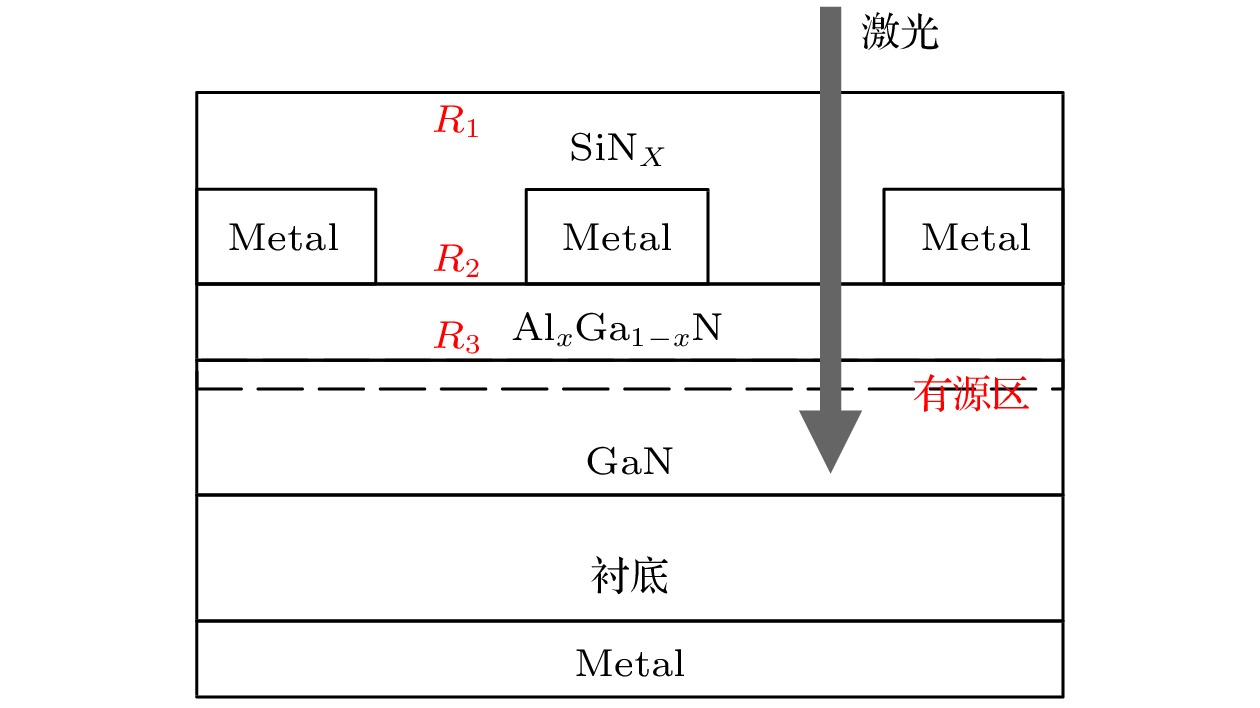
EDITOR'S SUGGESTION
2022, 71 (13): 136102.
doi: 10.7498/aps.71.20212297
Abstract +
The femtosecond pulsed laser is used to study the quantitative evaluation technology of the single event burnout (SEB) effect in GaN power devices. In this work, we establish two pulsed-laser effective energy transmission models for different device structures, analyzing and verifying the equivalent relationship between the effective laser energy and the heavy ion linear energy transmission (LET). The critical parameters of models are confirmed, including laser parameters and device parameters. The interface reflectivity between the layers is mainly considered. Meanwhile, the parameters are corrected by the multiple reflections between the interfaces, and the laser energy of the second reflection of the metal layer is considered. These measures can be used to reduce the error of the effective energy in the device active area. In addition, we validate the models experimentally. A gallium nitride high electron mobility transistor (GaN HEMT) and a schottky barrier diode (SBD) power device are used in the experiment on the irradiation by a femtosecond pulse laser. The effective laser energy thresholds and the laser equivalent LET threshold with two incident wavelengths of the SEB are calculated. The theoretical calculation value and the actual measured value are compared. The selcction basis of the laser wavelengths is given by the detailed study. The support for the laser quantitative evaluation and the protection design of the SEB in GaN power devices is provided by this work.
CONDENSED MATTER: ELECTRONIC STRUCTURE, ELECTRICAL, MAGNETIC, AND OPTICAL PROPERTIES

EDITOR'S SUGGESTION
2022, 71 (13): 137101.
doi: 10.7498/aps.71.20220060
Abstract +
The bilayer and thin films of Bi(111) have demonstrated novel topological properties. Here, we investigate the electronic structures of Bi/Bi2Te3(111) and Bi/Al2O3(0001) by combining first-principles and tight-binding approximation calculations. Our results show that the Bi(111) bilayer is a semiconductor with a gap of about 0.2 eV. Its electronic states are strongly disturbed by the interaction with Bi2Te3(111) thin films, no matter whether the substrate has a band gap or Dirac surface state. Moreover, it is hard to see Rashba-type band splittings in such systems. In contrast, it demonstrates clean and giant Rashba-type splittings as strongly hybridized with insulating Al2O3(0001), which is due to the broken inversion symmetry induced by interfacing and the strong atomic spin-orbit coupling in Bi. Our tight-binding approximation analyses further reveal that the effect of substrate Al2O3(0001) on the band structure of the Bi(111) bilayer is equivalent to the action of external electric field in a range between 0.5 and 0.6 V/Å. Moreover, we find that the strong hybridization between Bi(111) bilayer and the electronic state of the substrate Bi2Te3(111) can lead to a topological phase transition, i.e. the change from a two-dimensional topological insulator into a mediocre insulator. Our study thus provides an insight into the interface-engineering of electronic states of Bi(111) bilayer.
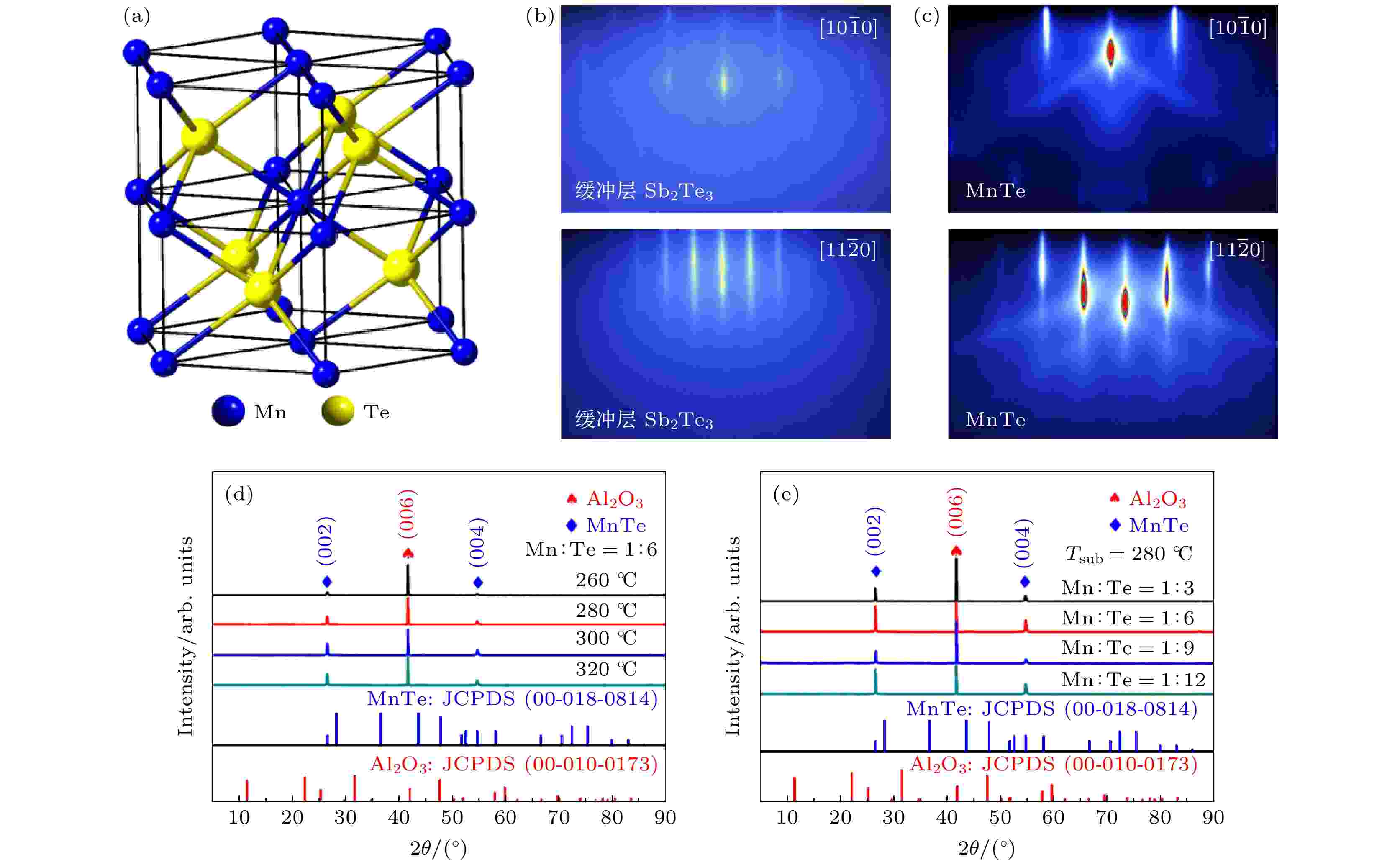
2022, 71 (13): 137102.
doi: 10.7498/aps.71.20212350
Abstract +
The NiAs-type MnTe compound is one of important and environmental friendly p-type thermoelectric materials for generating intermediate temperature powern. The low hole concentration in the pristine MnTe greatly restricts its thermoelectric performance. However, the systematic experimental studies of thermoelectric materials are still lacking so far. In this work, MnTe thin films are grown by molecular beam epitaxy (MBE) technique, and their intrinsic point defect structures are characterized by scanning tunneling microscope (STM). Through the regulation of the intrinsic point defects, the electrical transport performances of MnTe films are remarkably improved. The results show that Mn vacancies (VMn) and Te vacancies (VTe) are the dominant intrinsic point defects in MnTe film. With the increase of the substrate temperature (Tsub) and the decrease of the Mn:Te flux ratio, the hole concentration in MnTe film increases greatly, reaching a maximum value of 21.5 × 1019 cm–3, which is one order of magnitude higher than that of the intrinsic MnTe bulk. This is attributed to the significantly increased concentration of p-type VMn in MnTe film, and thus leads the conductivity (σ) and power factor (PF) to increase remarkably. Finally, the MnTe film grown at Tsub = 280 ℃ and Mn∶Te = 1∶12 obtains the maximum PF of 1.3 μW·cm–1·K–2 at 483 K in all grown films. This study clarifies the characteristics of intrinsic point defects and their relationship with the electrical transport properties of MnTe based compounds, which provides an importantguidance for further optimizing their thermoelectric performances.
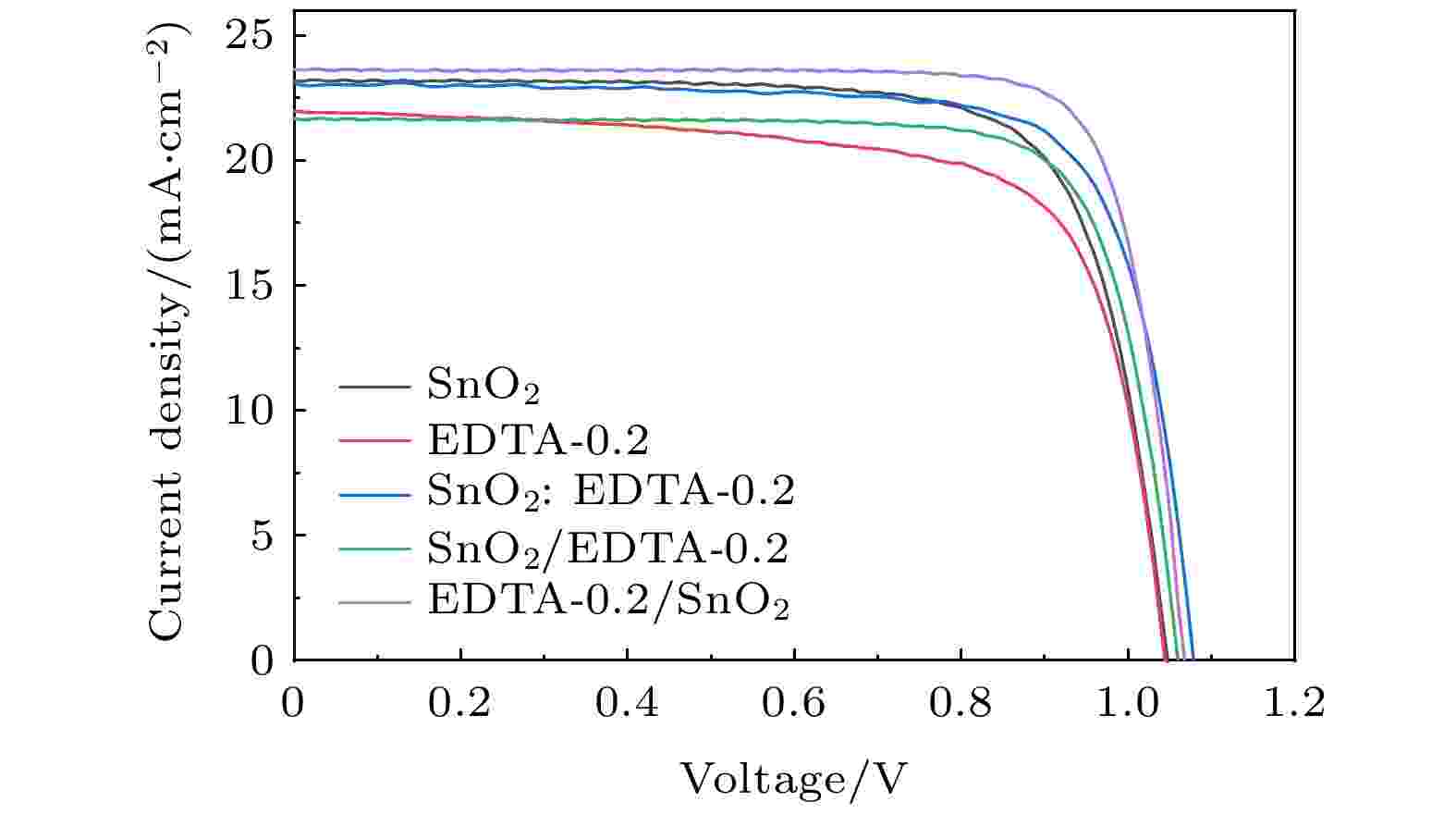
2022, 71 (13): 137201.
doi: 10.7498/aps.71.20220074
Abstract +
Organic-inorganic hybrid perovskite solar cell devices have received wide attention because of their high efficiency, and interface problem is one of the key problems in the preparation of perovskite solar cells. An efficient double-layered ethylene diamine tetraacetic acid (EDTA)/SnO2 composite structure, the ultrathin EDTA layer in contact with ITO electrode and an SnO2 layer interfaced with the perovskite, is developed as an electron-transport layer (ETL) in the preparation of perovskite solar cells. It is interesting that the surface morphology of the top SnO2 side of the composite ETL can be finely adjusted by tuning the underneath EDTA layer. These control the nucleation process in crystallization of the perovskite layer and adjust carrier extraction process between the electron transport and perovskite layers. High performance perovskite solar cells having a certified power conversion efficiency of 20.2% with negligible hysteresis are achieved.

EDITOR'S SUGGESTION
2022, 71 (13): 137301.
doi: 10.7498/aps.71.20212424
Abstract +
The electronic eigen-energy and the Landauer conductance of the finite Su-Schriefer-Heeger (SSH) lattice are calculated carefully, and the different effects of the lead-sample coupling strength on the conductance peaks of the bulk states and edge states are investigated. Only under the weak coupling limit, can the conductance peaks demonstrate the eigen-energy of all bulk states and edge states. With the increase of coupling strength, all the conductance peaks gradually deviate from their corresponding eigen-energy values and become wider, and the conductance peaks of the edge states will gradually disappear. In particular, after the coupling strength continues to increase to a large enough value, the conductance peaks gradually narrow again, but two of the peaks disappear, and the survival peaks will correspond to the eigen-energy of the remaining lattice system that does not contain the two atoms at both ends under the strong coupling limit. Therefore, the different responses of the conductance peaks to the varying coupling strength can be used to distinguish edge state from bulk states, and judge whether a system has any edge states.

2022, 71 (13): 137302.
doi: 10.7498/aps.71.20220095
Abstract +
In this paper, failure mechanism of DT 4H-SiC power MOSFET under unclamped inductive switch (UIS) test is evaluated by combination of experiment and theoretical research. The results show that unlike planar 4H-SiC power MOSFET, the gate oxide at the corner of of gate trench is destroyed under the UIS test, therefore, the device under test failed. And then, measurement results of the gate leakage and resistance between gate and source (Rgs) of the failed device indicate that gate leakage increases sharply and Rgs is only 25 Ω, however, the threshold voltage of failure device is unchanged. The analysis of the inner electrical field under avalanche state by using the TCAD software shows that the maximum electrical field exists at the corner of gate trench and the maximum junction temperature does not exceed the melt point of metal. These results are consistent with the experimental results .

EDITOR'S SUGGESTION
2022, 71 (13): 137401.
doi: 10.7498/aps.71.20211995
Abstract +
The superconductor will generate a magnetic field inside the superconductor during its rotation, which is called the London moment. At present, a variety of theories including London theory and G-L theory have explained the generation mechanism of London moment. Most of these theories essentially believe that the superconducting electrons in the surface layer of the rotating superconductor lag behind and have a net residual current. The London moment is produced by the net residual current on the surface of the rotating superconductor. However, there is still no clear theoretical explanation for the motion lag of the outermost superconducting electrons in rotating superconductors. In this paper the charged particles in the rotating system and the Berry phase of the superconductor in the rotating superconductor are analyzed. The results show that the Berry curvature of the superconductor has the same expression form as the London moment, indicating that the London moment may be the inverse effect of A-B effect, which is a macroscopic quantum effect based on Berry phase.

2022, 71 (13): 137801.
doi: 10.7498/aps.71.20220014
Abstract +
In this paper, NaCl: Cu circular dose tablets with a size of 5×1.8mm are prepared by sintering pure NaCl and CuCl powder as raw materials. They are placed in a four-element shell and sealed with plastic film to overcome the moisture absorption of the material. Their photoluminescence characteristics are studied by using an Inlight 200 automatic photoluminescence measurement system. The results show that the X-ray characteristic peaks of NaCl: Cu sintered at 650 ℃ and 400 ℃ appear at 27°, 32°, 45°, 56°, 66°, 75° and 84° respectively. Compared with the data given by XRD standard card of pure NaCl crystal (pdf-#88-2300), those peaks of the sample sintered at 650 ℃ are more consistent with the data given by the standard card. In the scanning electron microscope image, it can be seen that the grains are wholly welded and closely connected, and the characteristic grains in the sintering process have good welding effect. After Cu+ ion doping, the lattice structure of NaCl is slightly deformed. After high-temperature sintering, the mass transfer of Cu+ ions occurs at an atomic level in NaCl, and the particles are combined into a coherent solid structure. For X/γ-rays, the photoluminescence response of NaCl:Cu dose sheet to low-energy rays is higher than that of the same kind of rays with high energy. When using NaCl:Cu dose sheet to calculate the cumulative photoluminescence dose, it is necessary to consider the ray category and ray energy of the radiation source at the radiation site. The photoluminescence curve of NaCl:Cu dose sheet has typical exponential attenuation characteristics. The deflection angle of dose sheet has influence on the measured value: the greatest influence extent is 13.5%. With the increase of deflection angle of dose sheet, the area irradiated by γ-ray decreases, and the response of internal lattices to γ-ray decreases slightly. The uniformity of NaCl: Cu raw material particle sizes has a great influence on the distribution consistency of photoluminescence response of dose tablets. The decrease of sample particle size during tablet pressing can improve the contact surface area between NaCl and CuCl. The increase of contact surface area can improve the diffusion and transfer efficiency of Cu+ ions, increase the number of dose traps in the crystal, and make the overall count higher. When the particle sizes are more uniform, the Cu+ ion transferefficiencies and quantities of different dose tablets are close, the difference in the number of dose traps is reduced, and the photoluminescence sensitivities are closer. The coefficient of variation of the repeatability test experiment is 2.28%. The consistency of the repeated measurement data is good. The lattice structure and lattice defects of the material are not changed in the process of photoluminescence measurement and photoannealing. In a dose range of 1-1000mgy, with the increase of irradiation dose, the photoluminescence response of NaCl: Cu and NaCl dose tablets gradually increase and show a good linear relationship. The photoluminescence response of NaCl: Cu is 2-to-4 times higher than that of NaCl dose tablets. The NaCl: Cu dose tablets prepared by the sintering method can be used as dosimeters for monitoring personal or environmental dose.

Measurement of NOx concentration at ppb level in high-purity gases based on chemiluminescence method
2022, 71 (13): 137802.
doi: 10.7498/aps.71.20220061
Abstract +
High-purity gases are widely used in semiconductor device manufacturing and fuel cell industries. However, the impurities have a significant influence on the processing accuracy directly. Thus, it is particularly necessary to carry out the concentration diagnosis of key trace impurity gases. In this work, an integrated system for the simultaneous detection of trace NO/NOx is designed based on the chemiluminescence spectrum theory and the catalytic conversion mechanism of nitrogen oxides. The test experiments reveal that the measurement system has the advantages of high linearity (R2 = 0.99967), high sensitivity, low detection limit (~25 ppt), and easy operation. Subsequently, the measurement method for NOx with different high-purity gases are established considering the quenching effects of different background gases on fluorescence and phosphorescent. The detection system is then used to measure the ppb-level NOx impurities in four commonly used high-purity gases (Ar, O2, CO2, N2) in the laboratory. The results show that the NO impurity in CO2 gas is the highest, approximately 9 ppb,but relatively low, 0–4 ppb, in the other high-purity gases. The NO2 impurities in all four high-purity gases are very low (< 6 ppb). Finally, the NOx impurity content values in high-purity gases are evaluated and analyzed based on the gas preparation and purification approach. The aim of the work is to provide a reliable diagnostic approach and data basis of the impurity composition for the fuel cell, semiconductor and other cutting-edge technological fields.
INTERDISCIPLINARY PHYSICS AND RELATED AREAS OF SCIENCE AND TECHNOLOGY
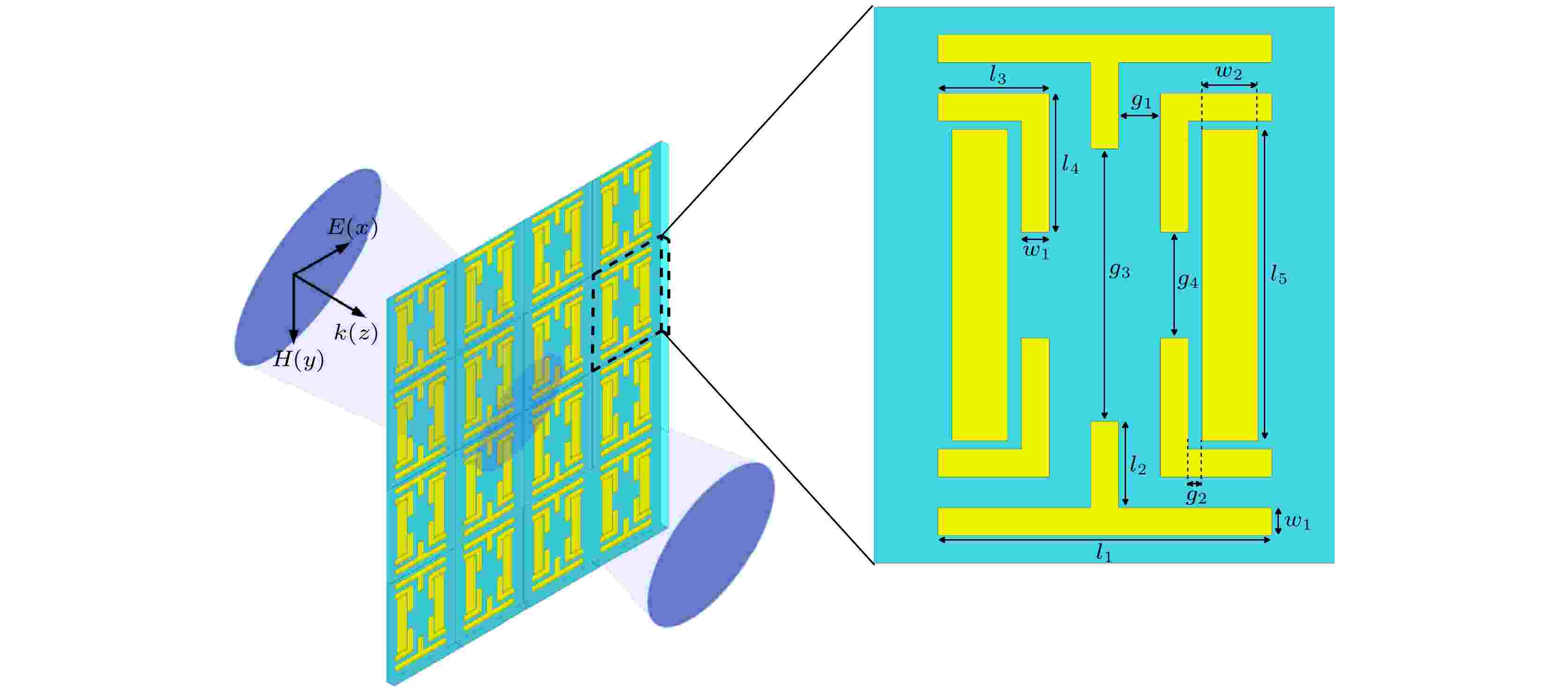
2022, 71 (13): 138101.
doi: 10.7498/aps.71.20212163
Abstract +
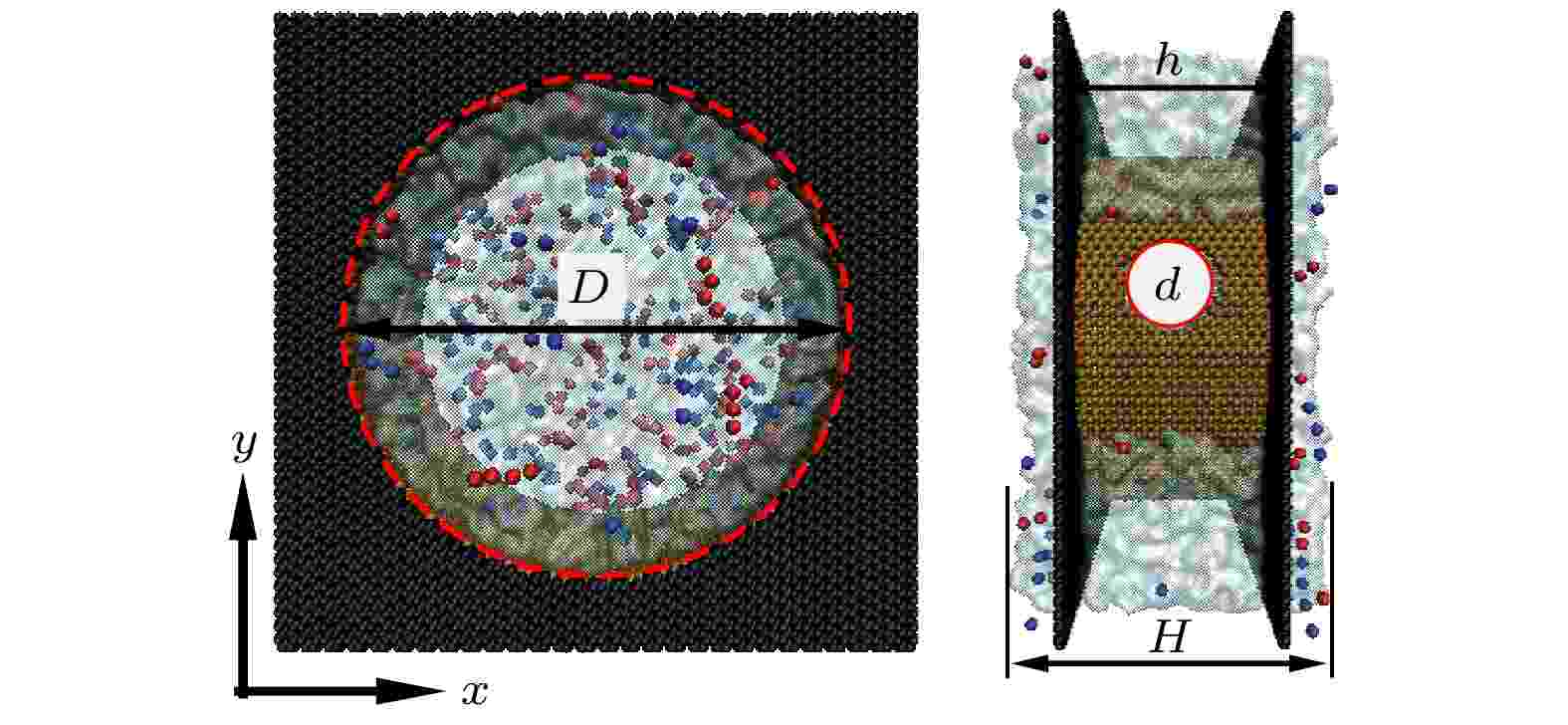
2022, 71 (13): 138201.
doi: 10.7498/aps.71.20212283
Abstract +
Reverse osmosis (RO) technology is currently the most progressive, energy-saving and efficient membrane separation technology . Meanwhile, graphene becomes a promising candidate for fabricating the RO membranes in water desalination due to its high salt rejection and water flux. The concept of “temporal selectivity” is first proposed in our previous work in terms of the time difference between the penetration time of an ion passing through the pore and the tangential slipping time for the ion sliding across the pore. Nevertheless, the temporal selectivity mechanism of multilayered graphene membrane remains ambiguous. In this paper, the RO process of saltwater through porous graphene column RO membrane is studied by using molecular dynamics (MD) simulations method, and the effects of rotating angular velocity and the thickness of RO membrane on desalination performance of seawater are considered first. The MD results show that the salt rejection increases with the rotation speed of porous membrane increasing while the water flux initially increases and then decreases . Meanwhile, the interfacial slip velocity increases linearly with angular velocity increasing. On the other hand, the increasing thickness of porous graphene membrane can enhance the selectivity and reduce the permeability of water molecules. As expected, the tri-layered porous graphene RO membrane can achieve high salt rejection at low interfacial slip velocity. In order to ensure high selectivity and energy conservation and efficient, the pore structure of the porous graphene RO membrane is optimized. The results show that the optimized nanopores can increase the water flux significantly, whereas the salt rejection is not changed appreciably. It is found that the pore size of the innermost layer membrane near the feed region has the most significant effect on the water flux. The water flux increases sharply with the increase of pore diameter and the salt rejection remains totally higher than 80%. Moreover, the RO membrane with a special Type 3 structure exhibits excellent performance in seawater desalination, specifically, the ultrahigh water flux reaches 20029 L·cm–2·d–1 and the super salt rejection arrives at 94%. The research results further clarify and verify the mechanism of the temporal selectivity in RO process, and improve the water flux under the condition of the same membrane thickness by designing gradient hole. The findings can conduce to the in-depth theoretical understanding of porous graphene-based membranes and designing and developing the large-scale seawater desalination devices and water filtration equipment.

2022, 71 (13): 138501.
doi: 10.7498/aps.71.20220241
Abstract +
The pH-sensitive organic electrochemical transistors are expected to be widely used in wearable electronic devices for in-situ physiological monitoring. However, the unclear current-voltage relationship seriously hinders it from developing in design, optimization, and application. In the present work, the current-voltage characteristic of pH-sensitive organic electrochemical transistor is investigated by combining the electrochemical equilibrium equation with the series model of differential capacitances formed at gate electrode/electrolyte and semiconductor channel/electrolyte interface. Moreover, a pH-sensitive organic electrochemical transistor is constructed by using poly (3,4-ethylenedioxythiophene)/polystyrene sulfonate as the semiconductor layer material and modifying the gate electrode with pH-sensitive polymer (poly (3,4-ethylenedioxythiophene)/bromothymol blue). The effectiveness of the theoretical model is verified by investigating the output, transfer, and pH response characteristics of the pH-sensitive organic electrochemical transistor. The experimental results show that the detection sensitivity can reach up to 0.22 mA·pH·unit–1, and the pH response is gate-bias dependent. Then, a polynomial indicating the gate bias effect is introduced to modify the current-voltage characteristic equation. The goodness of fitting the theoretical model to the experimental results of transfer curves is found to be 0.998. The comparison between experimental and theoretical results of the gate bias corresponding to the peak transconductance and pH sensitivity responding to gate bias can also verify the effectiveness of the modified theoretical model. The results can provide theoretical support for the design and manufacture of pH-sensitive organic electrochemical transistors based flexible biosensors.

EDITOR'S SUGGESTION
2022, 71 (13): 138502.
doi: 10.7498/aps.71.20220154
Abstract +
In this paper, we fabricate a back channel etched structure thin film transistor (TFT) pixel array with hafnium-aluminum oxide dielectric and indium-zinc-tin-oxide (IZTO) semiconductor using a solution process. The electrical characteristics of IZTO TFT are modified by N2O plasma treatment. In comparison with the subthreshold swing and saturation mobility of the device untreated by plasma , the subthreshold swing decreases from 204 to 137 mV·dec–1, and the saturation mobility increases from 29.12 to 51.52 cm2·V–1·s–1. Improvement in the mobility and the subthreshold swing (SS) demonstrate that interface states may be passivated by reactive O radicals that are generated by N2O plasma, which is confirmed by the result of X-ray photoelectron spectrum analysis. In addition, the stability of negative bias illumination stress (NBIS) shift is only 0.1V for 3600 s with an illumination intensity of 10000 lux. This result indicates that its superior stability meets the requirements for the display driver. Therefore, N2O plasma treatment is verified to be an effective method to improve device performance and light stability for IZTO TFT pixel array.








